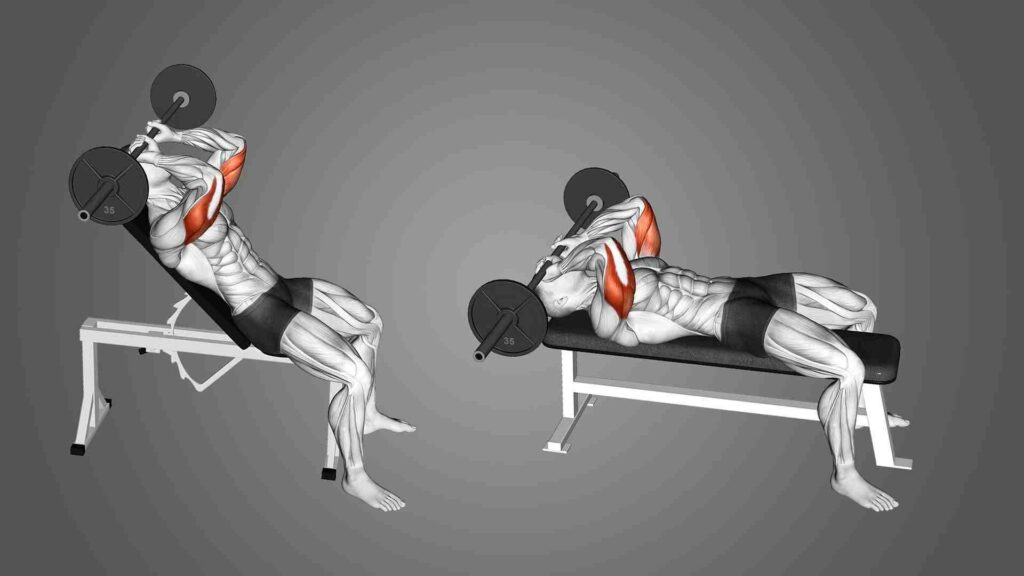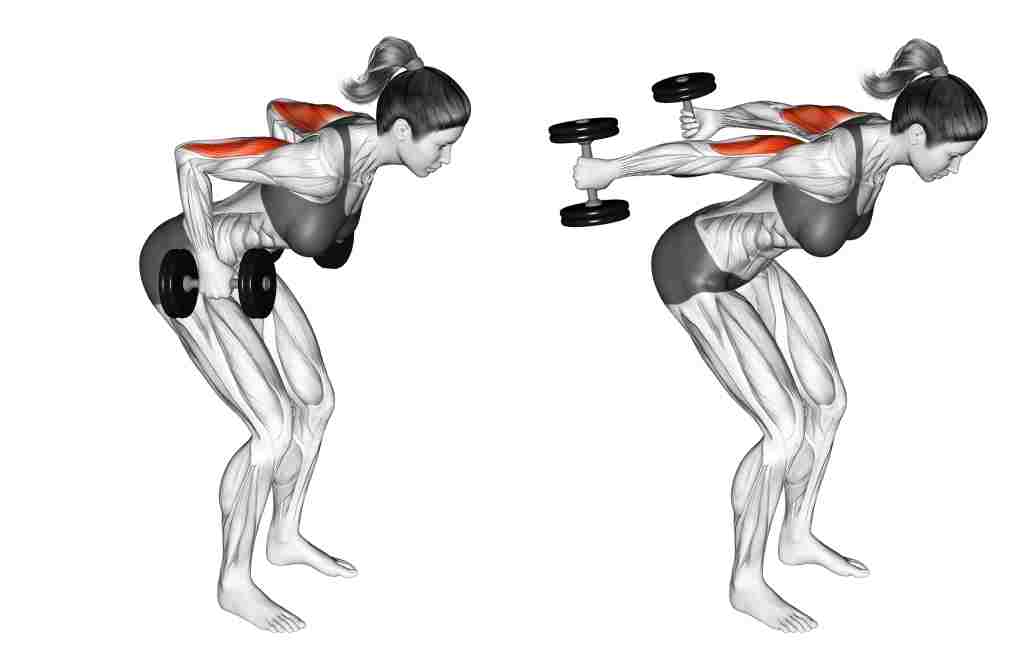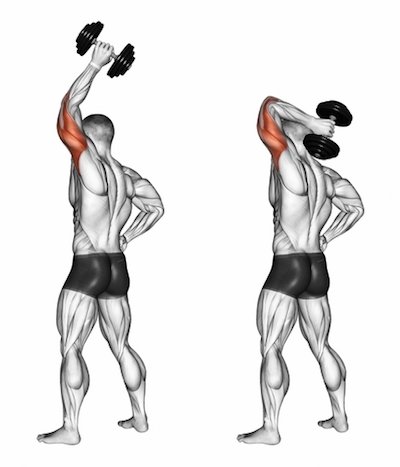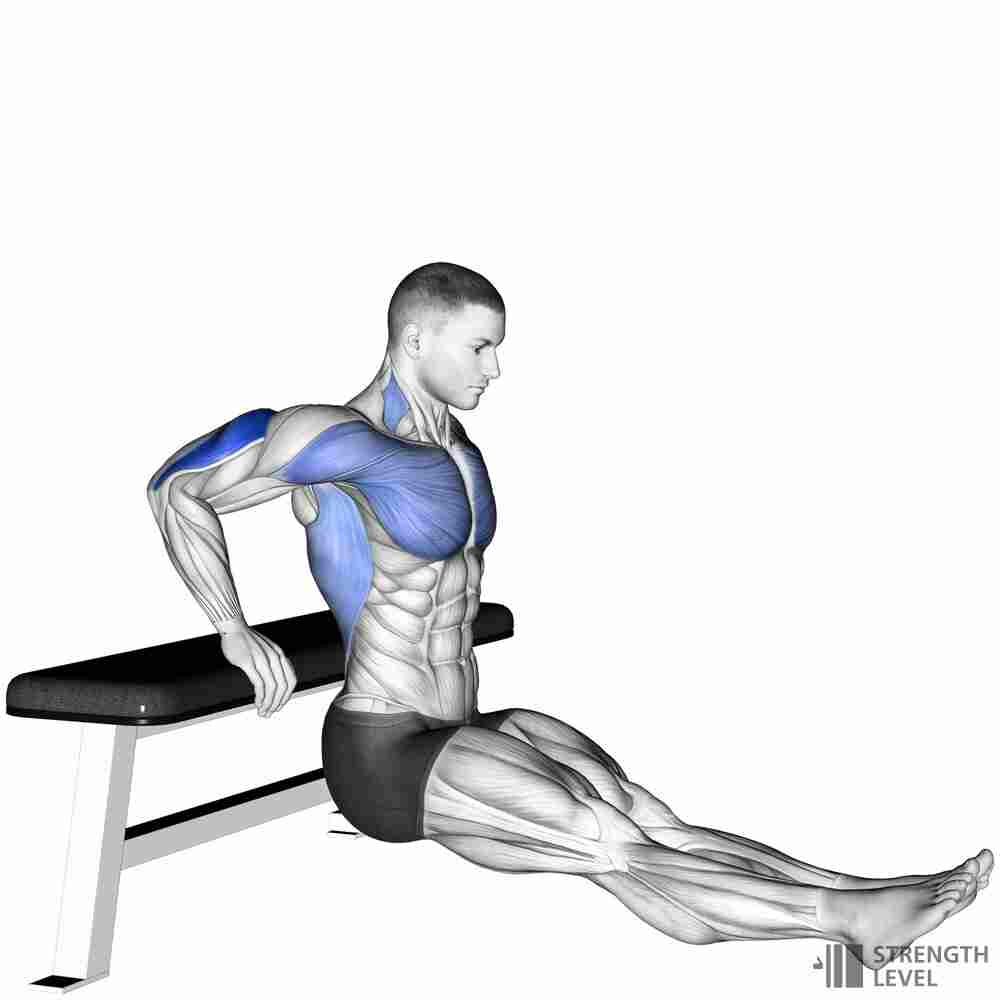When it comes to building strong and defined arms, the triceps play a major role. The triceps have three parts, and the long head is the largest of them all. Targeting the long head of the triceps is key to making your arms look bigger and more muscular. In this article, we’ll explore the best long head tricep exercises, why they’re important, and how to include them in your workout routine. Whether you’re new to strength training or a seasoned gym-goer, these tips will help you take your arm workouts to the next level.
Anatomy of the Triceps

The triceps brachii, commonly known as the triceps, is a large muscle located on the back of the upper arm. As the name “triceps” suggests, it consists of three distinct heads: the long head, the lateral head, and the medial head. Each of these heads plays a specific role in the function and appearance of the triceps muscle.
1. Long Head
- Location: The long head is the most prominent and largest of the three heads. It originates from the infraglenoid tubercle of the scapula (shoulder blade) and runs down the length of the upper arm, inserting into the olecranon process of the ulna (one of the forearm bones).
- Function: The long head of the triceps is unique because it crosses both the shoulder and elbow joints. This allows it to contribute to both elbow extension (straightening the arm) and shoulder extension (moving the arm backward). It also plays a role in stabilizing the shoulder joint during certain movements.
- Significance in Training: Targeting the long head is crucial for achieving well-rounded tricep development, as it adds significant mass and shape to the upper arm.
2. Lateral Head
- Location: The lateral head is positioned on the outer side of the upper arm. It originates from the posterior surface of the humerus (upper arm bone), above the radial groove.
- Function: The lateral head is primarily responsible for extending the elbow. It is the most visible head of the triceps when the arm is in a relaxed position and contributes to the overall width of the upper arm.
- Significance in Training: Exercises that target the lateral head help enhance the outer sweep of the triceps, giving the arms a more defined appearance.
3. Medial Head
- Location: The medial head lies beneath the long and lateral heads, closer to the midline of the body. It originates from the posterior surface of the humerus, below the radial groove.
- Function: Like the lateral head, the medial head is involved in elbow extension. It is the workhorse of the triceps, providing power and stability during arm movements.
- Significance in Training: While not as visible as the other two heads, the medial head contributes to the overall thickness and strength of the triceps.
SHOP FOR THE ADJUSTABLE DUMBBELL SET ON AMAZON
By knowing the specific functions and locations of each tricep head, you can tailor your workouts to target these muscles more effectively, leading to balanced and impressive arm development.
Benefits of Training the Long Head of the Triceps
Training the long head of the triceps offers several advantages that can enhance your overall arm development and upper body strength. Here are some key benefits:
Bodyweight Training Effectiveness
- Increased Arm Size and Definition: The long head is the largest part of the triceps, and targeting it can significantly increase the size and definition of your upper arms.
- Improved Shoulder Stability: The long head of the triceps attaches to the scapula, playing a crucial role in shoulder stability. Strengthening this muscle can help improve shoulder joint stability and reduce the risk of injuries.
- Enhanced Upper Body Strength: Strong triceps are essential for various upper body movements, including pressing exercises like bench presses and overhead presses. Training the long head can improve your performance in these exercises.
- Balanced Muscle Development: Focusing on the long head ensures balanced tricep development, preventing muscle imbalances that can lead to poor posture and potential injuries.
- Better Aesthetics: A well-developed long head contributes to the “horseshoe” shape of the triceps, giving your arms a more muscular and aesthetically pleasing appearance.
- Functional Strength: The long head assists in shoulder extension and adduction, making it important for functional movements and activities that involve pushing and lifting.
- Improved Joint Flexibility: Training the long head can enhance the flexibility of both the shoulder and elbow joints, contributing to better overall joint health.
- Enhanced Athletic Performance: Athletes and bodybuilders can benefit from a well-developed long head, as it plays a crucial role in pushing movements and overall upper body stability.
- Better Posture: Strengthening the long head of the triceps can help improve posture by supporting the muscles around the shoulder joint.
SHOP FOR THE ADJUSTABLE WEIGHT BENCH ON AMAZON
By incorporating long head tricep exercises into your workout routine, you can enjoy these benefits and achieve stronger, more defined arms.
10 Best Long Head Tricep Exercises
When it comes to building the long head of the triceps, certain exercises are more effective at targeting this specific part of the muscle. Here are some of the most effective long head tricep exercises:
1. Overhead Tricep Extension
This exercise isolates the long head of the triceps by extending the arm overhead and then lowering the weight behind the head.

How to Process:
- Stand or sit with a dumbbell or barbell held overhead with arms fully extended.
- Keep your elbows close to your head and lower the weight behind your head.
- Extend your arms back to the starting position.
Tips:
- Avoid flaring elbows out to maintain focus on the long head.
- Keep your core tight to prevent arching your lower back.
- Use a lighter weight if you’re new to this exercise to master the form.
2. Close-Grip Bench Press
This variation of the bench press emphasizes the triceps, particularly the long head.

How to Process:
- Lie on a bench with your hands placed closer than shoulder-width apart on the barbell.
- Lower the barbell to your chest while keeping your elbows close to your body.
- Push the barbell back up to the starting position.
Tips:
- Keep your wrists straight and elbows tucked to reduce shoulder strain.
- Maintain control over the barbell throughout the movement.
- Avoid using excessively heavy weights to ensure proper form.
3. Skull Crushers (Lying Tricep Extensions)
This exercise targets the triceps by extending the arms from a bent position while lying on a bench.

How to Process:
- Lie on a bench with a barbell or dumbbell held above your chest.
- Bend your elbows to lower the weights toward your forehead.
- Extend your arms back to the starting position.
Tips:
- Keep your upper arms stationary and only move your forearms.
- Use a controlled motion to avoid stressing your elbows.
- Start with lighter weights to perfect your form.
4. Dips
Dips effectively target the triceps and can emphasize the long head when performed with a forward lean.

How to Process:
- Grip parallel bars with your arms fully extended and your body hanging down.
- Lean slightly forward and lower your body by bending your elbows.
- Push yourself back up to the starting position.
Tips:
- Lean forward to emphasize the triceps over the chest.
- Maintain a controlled motion to avoid shoulder strain.
- If bodyweight dips are too challenging, use an assisted dip machine or resistance bands.
5. Tricep Kickbacks
This isolation exercise targets the long head by extending the arm backward while supporting your body on a bench.

How to Process:
- Place one knee and hand on a bench for support.
- Hold a dumbbell in the opposite hand with your upper arm parallel to the floor.
- Extend your arm back until it is fully straightened.
- Return to the starting position.
Tips:
- Keep your upper arm still to focus on the tricep.
- Avoid using excessive weights to maintain proper form.
- Perform the exercise slowly to maximize muscle engagement.
6. Cable Overhead Tricep Extension
This variation of the overhead extension uses a cable machine for continuous tension.

How to Process:
- Attach a rope to the high pulley of a cable machine.
- Grip the rope with both hands and extend your arms overhead.
- Lower the rope behind your head by bending your elbows.
- Extend your arms back to the starting position.
Tips:
- Maintain a slight bend in your knees and keep your core engaged.
- Use a full range of motion to maximize tricep activation.
- Adjust the cable height to ensure proper tension throughout the exercise.
7. French Press (Seated Tricep Extension)
This seated version of the tricep extension focuses on the long head while seated for added stability.

How to Process:
- Sit on a bench with a dumbbell or barbell held overhead.
- Lower the weight behind your head by bending your elbows.
- Extend your arms to return to the starting position.
Tips:
- Keep your back straight and avoid arching.
- Use a controlled motion to prevent injury.
- Start with lighter weights to perfect your form before progressing.
8. Reverse Grip Tricep Pushdown
This exercise uses a reverse grip to shift focus to the long head of the triceps during pushdowns.

How to Process:
- Attach a bar to the high pulley of a cable machine.
- Grip the bar with your palms facing up.
- Push the bar down until your arms are fully extended.
- Slowly return to the starting position.
Tips:
- Keep your elbows close to your body throughout the movement.
- Avoid using excessive weight to maintain control and proper form.
- Focus on squeezing your triceps at the bottom of the movement.
9. Single-Arm Overhead Tricep Extension
This unilateral exercise isolates each tricep individually, ensuring balanced development.

How to Process:
- Hold a dumbbell in one hand and extend your arm overhead.
- Lower the weight behind your head by bending your elbow.
- Extend your arm back to the starting position.
- Repeat on the other side.
Tips:
- Perform the exercise slowly to focus on the muscle contraction.
- Keep your upper arm stationary and avoid swinging the weight.
- Use a moderate weight to avoid straining your shoulder.
10. Tricep Bench Dip
This bodyweight exercise targets the triceps with minimal equipment, emphasizing the long head when done correctly.

How to Process:
- Sit on the edge of a bench with your hands next to your hips.
- Move your hips forward and extend your legs out in front.
- Lower your body by bending your elbows until your upper arms are parallel to the floor.
- Push yourself back up to the starting position.
Tips:
- Keep your back close to the bench to focus on the triceps.
- Avoid lowering your body too much to prevent shoulder strain.
- For added intensity, place a weight on your lap or elevate your feet.
SHOP FOR THE RESISTANCE BAND ON AMAZON
These long head tricep exercises, when performed correctly and consistently, can effectively target the long head of the triceps and contribute to overall arm development.
7-Day Sample Workout Routine
Here’s a 7-day workout routine that incorporates these long head tricep exercises, along with other muscle groups to ensure balanced development. This routine assumes you’re working out five days a week, with two rest or active recovery days. The focus is on targeting the triceps while also working on other major muscle groups for a well-rounded fitness program.
Post-Workout Carbs and Muscle Loss
Day 1: Chest & Triceps
- Close-Grip Bench Press: 4 sets of 8-10 reps
- Overhead Tricep Extension: 3 sets of 10-12 reps
- Skull Crushers (Lying Tricep Extensions): 3 sets of 10-12 reps
- Push-Ups (with a focus on triceps): 3 sets of 15-20 reps
- Tricep Kickbacks: 3 sets of 12-15 reps
Day 2: Back & Biceps
- Pull-Ups: 4 sets of 8-10 reps
- Bent-Over Rows: 4 sets of 8-10 reps
- Single-Arm Dumbbell Rows: 3 sets of 10-12 reps each arm
- Hammer Curls: 3 sets of 10-12 reps
- Reverse Grip Tricep Pushdown: 3 sets of 12-15 reps
Day 3: Legs
- Squats: 4 sets of 8-10 reps
- Leg Press: 4 sets of 10-12 reps
- Lunges: 3 sets of 10-12 reps per leg
- Leg Curls: 3 sets of 12-15 reps
- Standing Calf Raises: 3 sets of 15-20 reps
Day 4: Shoulders & Triceps
- Overhead Press: 4 sets of 8-10 reps
- Lateral Raises: 3 sets of 12-15 reps
- Cable Overhead Tricep Extension: 3 sets of 10-12 reps
- Dips: 3 sets of 10-15 reps (add weight if needed)
- Tricep Bench Dip: 3 sets of 15-20 reps
Day 5: Full Body (Focus on Triceps)
- Deadlifts: 4 sets of 6-8 reps
- Bench Press: 4 sets of 8-10 reps
- Single-Arm Overhead Tricep Extension: 3 sets of 10-12 reps each arm
- French Press (Seated Tricep Extension): 3 sets of 10-12 reps
- Push-Ups (close-grip for triceps): 3 sets of 15-20 reps
Day 6: Rest or Active Recovery
- Light cardio (walking, cycling, swimming)
- Stretching and mobility work
- Foam rolling to relieve muscle tension
Day 7: Rest or Active Recovery
- Yoga or Pilates for flexibility and core strength
- Low-intensity activities like hiking or a light jog
SHOP FOR THE PROTEIN POWDER ON AMAZON
This routine provides a balanced approach to building strength in your triceps while also working on other major muscle groups. Adjust the weights, sets, and reps according to your fitness level and goals.
FAQs
Q 1. What is the best time to do long head tricep exercises?
Ans. The best time to do long head tricep exercises depends on your overall workout routine. If you’re doing a dedicated arm day, you can start with tricep exercises. If you’re incorporating tricep exercises into a push day, you might want to do them after your main compound lifts like bench presses or shoulder presses. The key is to ensure you’re not too fatigued to maintain proper form.
Q 2. How often should I train my triceps for optimal growth?
Ans. For optimal growth, it’s recommended to train your triceps 2-3 times per week. This frequency allows for adequate recovery while providing enough stimulus for muscle growth. Make sure to vary the exercises and intensity to avoid overtraining.
Q 3. Can I do long head tricep exercises at home without equipment?
Ans. Yes, you can do long head tricep exercises at home without equipment. Bodyweight exercises like triangle push-ups, bench dips, and close-grip push-ups are effective for targeting the long head. You can also use household items like water bottles or resistance bands for added resistance.
Q 4. What are the signs of overtraining the triceps
Ans. Signs of overtraining the triceps include persistent muscle soreness, decreased performance, fatigue, and increased risk of injury. If you experience these symptoms, it’s important to take a break, allow your muscles to recover, and adjust your workout routine to prevent overtraining.
Q 5. How can I prevent injuries while training the long head of the triceps?
Ans. To prevent injuries, always warm up before your workout, use proper form, and avoid lifting weights that are too heavy. Incorporate stretching and mobility exercises to maintain flexibility, and listen to your body to avoid pushing through pain.
Q 6. Are there any specific stretches for the long head of the triceps?
Ans. Yes, there are specific stretches for the long head of the triceps. One effective stretch is the overhead tricep stretch: raise one arm overhead, bend the elbow, and use the opposite hand to gently push the elbow back. Hold for 20-30 seconds and repeat on the other side.
Q 7. Can women benefit from training the long head of the triceps?
Ans. Absolutely! Women can benefit from training the long head of the triceps just as much as men. Strengthening the triceps can improve arm definition, enhance upper body strength, and support overall functional fitness. It also helps in maintaining muscle mass and bone density.
Conclusion
Training the long head of the triceps is essential for anyone looking to build stronger, more defined arms. By understanding the anatomy of the triceps and incorporating effective long head tricep exercises into your routine, you can achieve impressive results. Remember to focus on proper form, avoid common mistakes, and give your muscles time to recover. With dedication and consistency, you’ll see improvements in your arm size, strength, and overall upper body stability.

Good day, and welcome to Fitthour. My name is Shubham Vijay, and I am a certified personal trainer and nutrition coach with 6 years of experience in the fitness industry. At Fitthour, we specialize in types of training, such as strength training, cardio, or HIIT, and our mission is to help clients achieve their fitness goals and improve their overall health.
